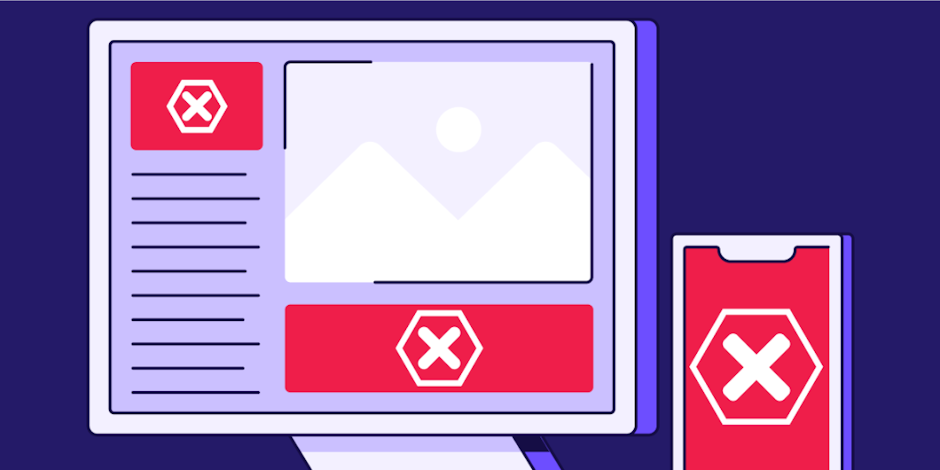Why should good advertisers care about bad ads?
By John Murphy, chief strategy officer

The answer to the seemingly simple question is complicated because digital advertising is so interconnected, and its scale is huge. Billions of ads are served every day by a complex ecosystem of programmatic advertising providers that often places bad ads alongside good ads on the same publishers’ pages or apps.
A study by Redpoint Global reported that “70% of consumers reported receiving mistargeted information at least once a month and 24% say they receive mistargeted information daily.” Users — blissfully unaware of the complexities of programmatic advertising — tend to associate any bad ad experience with the publisher or with digital advertising as a whole, damaging reputations, reducing user trust, and often driving the use of ad blockers. This, in turn, decreases the effectiveness of advertising campaigns from all advertisers.
How is malvertising related to bad ads?
Bad ads include ads with security, quality or privacy violations that degrade the user experience. These issues can range from merely annoying to outright criminal activity. A particularly malicious form of bad ads called malvertising is used by threat actors to target users for illegal or unethical purposes.
Confiant’s 2023 Malvertising and Ad Quality Index states that ad security violations nearly doubled in 2022, reaching a three-year high. Malvertising includes advertisements used for financial scams, phishing, forced redirects, compromised ads/sites/landing pages, cloaked ads/landing pages, drive-by software/files, and other malicious activity. Some bad actors cloak their ads or serve them only to a specific target audience with malicious intent. More information about the various forms of malvertising and the tactics used by threat actors can be found at matrix.confiant.com.
Jerome Dangu, CTO and co-founder at Confiant, uncovered malvertising activity that combined cookie stuffing, ad fraud, cloaking, and privacy consent violations to trigger invalid ad conversions in his article “Malvertiser Makes the Big Bucks on Black Friday”. The malicious campaigns were shut down after this article uncovered more than 125 million display suspect ad impressions during 2022.
Bad actors also use deceptive tactics to obtain personal information, which erodes users' trust in the online advertising ecosystem and reduces engagement for all advertisers. A real case of consent string steganography is discussed in the article "Voldrakus: Consent String Steganography Exfiltrating Data Collection" by Kaileigh McCrea, privacy engineer at Confiant.
Bad ad user pushback
Bad ad experiences can significantly contribute to the adoption of ad blockers by users. And the effect on audience size is not small. Statista reported that “during the third quarter of 2021, the average global ad blocking rate was estimated at 37%.” “In the United States, 34.2% of internet users said they used adblockers.” Here's why it happens:
Intrusive and disruptive ads: Ads that are intrusive, such as pop-ups, auto-playing videos with sound, or ads that cover the entire screen, can create a negative user experience. These intrusive elements interrupt the user's browsing flow, leading to frustration and annoyance.
Scam ads: Ads that lead to scams have severe negative effects on users and advertisers alike. For the victims of the scams, they cause financial loss, identity theft, and fraud, inflict psychological distress, and erode their trust in advertising. Additionally for publishers and platforms, scam ads damage their reputations, create legal and regulatory challenges while undermining the overall security and integrity of their platform.
Slow page loading times: Ads that are poorly optimized or contain large file sizes can slow down website loading times. Users expect websites to load quickly, and if they encounter slow loading due to heavy ad content, it can result in a poor user experience.
Irrelevant and repetitive ads: When users are bombarded with ads that are irrelevant to their interests or needs, it can be irritating. Seeing the same ad repeatedly across different websites can also lead to ad fatigue and a negative perception of the advertiser.
Privacy and security concerns: Advertisements often rely on tracking technologies to collect user data for targeting purposes. This can raise privacy concerns among users who are wary of their online activities being monitored. Users may view ad blockers as a way to protect their privacy and security.
Negative experiences drive users to seek solutions like ad blockers, which are browser extensions or software designed to block ads from being displayed.
The effects of ad blockers on publisher revenue are well known, but they also significantly limit the reach available to good advertisers. When users employ ad blockers, it means they are no longer part of the addressable audience. These users basically cease to exist as far as programmatic advertising is concerned, with very limited exceptions.
What can be done to eliminate bad ads?
In order to maintain a trusted and effective digital advertising ecosystem, every participant must do their part by using highly effective ad security and verification systems like Confiant to purge bad ads from the network. It’s vital for good advertisers to care about the repercussions of sharing inventory with bad ads and demand that their partners take steps to prevent bad actors from endangering individuals and raising suspicion about the entire ecosystem.
The problem cannot be solved by any one member working alone. However, if every member of the ad ecosystem works together to promote transparency, accountability, and responsible advertising practices, it will ensure a better future for digital advertising as a trusted and effective channel for reaching audiences.

